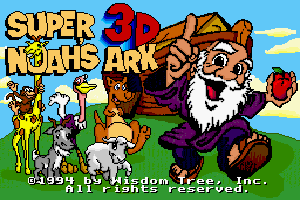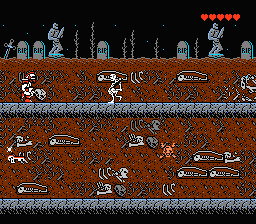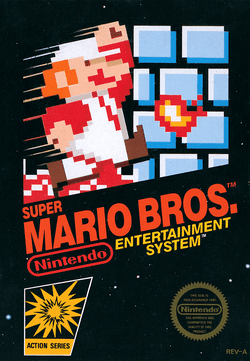
A platformer is a subgenre of action game in which the core objective is to move the player character between points in an environment. Platform games are characterized by levels with uneven terrain and suspended platforms that require jumping and climbing to traverse. Other acrobatic maneuvers may factor into the gameplay, such as swinging from vines or grappling hooks, jumping off walls, gliding through the air, or bouncing from springboards or trampolines.

Dr. Mario is a 1990 puzzle video game developed and published by Nintendo for the Nintendo Entertainment System and Game Boy. It was produced by Gunpei Yokoi and designed by Takahiro Harada. The soundtrack was composed by Hirokazu Tanaka.

Super Mario Bros. 3 is a 1988 platform game developed and published by Nintendo for the Nintendo Entertainment System (NES). It was released for home consoles in Japan on October 23, 1988, in North America on February 12, 1990, and in Europe on August 29, 1991. It was developed by Nintendo Entertainment Analysis and Development, led by Shigeru Miyamoto and Takashi Tezuka.

Yoshi is a fictional dinosaur who appears in video games published by Nintendo. Yoshi debuted in Super Mario World (1990) on the SNES as Mario and Luigi's sidekick. Throughout the mainline Super Mario series, Yoshi typically serves as Mario's trusted steed. With a gluttonous appetite, Yoshi can gobble enemies with his long tongue, and lay eggs that doubly function as projectiles. Yoshi is the title character of the Yoshi series and a supporting character in the Mario franchise. He has appeared in Mario Party and Mario Kart, as well as many Mario sports games. He also appears as a playable character in the crossover fighting game series Super Smash Bros. Yoshi is a member of the same-named species, which is distinguished for its wide range of colors.

Super Mario Bros. 2 is a 1988 platform game developed and published by Nintendo for the Nintendo Entertainment System. After the smash hit Super Mario Bros. in 1985, Nintendo quickly released a minor adaptation of the original with advanced difficulty titled Super Mario Bros. 2, for its mature market in Japan in 1986. However, Nintendo of America found this sequel too similar to its predecessor, and its difficulty too frustrating, for the nascent American market. This prompted a second Super Mario Bros. sequel based on Yume Kōjō: Doki Doki Panic, Nintendo's 1987 Family Computer Disk System game which had been based on a prototype platforming game and released as an advergame for Fuji Television's Yume Kōjō '87 media technology expo. The characters, enemies, and themes in Doki Doki Panic have the mascots and theme of the festival, and were adapted into the Super Mario theme to make a Western Super Mario Bros. sequel.

Super Mario Bros.: The Lost Levels is a 1986 platform game developed and published by Nintendo. A sequel to Super Mario Bros. (1985), it was originally released in Japan for the Family Computer Disk System as Super Mario Bros. 2 on June 3, 1986. Nintendo of America deemed it too difficult for its North American audience and instead released an alternative sequel, also titled Super Mario Bros. 2, in 1988. It was remade and renamed The Lost Levels for the 1993 Super Nintendo Entertainment System compilation Super Mario All-Stars, serving as its first international release. It has been rereleased for Game Boy Color, Game Boy Advance, Wii, Wii U, Nintendo 3DS, and Nintendo Switch.

Super 3D Noah's Ark is a non-violent Christian first-person shooter developed and published by Wisdom Tree for the Super Nintendo Entertainment System (SNES) in 1994 and MS-DOS in 1995. Its gameplay is similar to that of Wolfenstein 3D, as Wisdom Tree had licensed that game's engine from id Software. Wisdom Tree opted not to secure a license from Nintendo for the game's SNES release. While not illegal, it prevented the game from being sold at most video game retailers, which were under a contractual agreement with Nintendo not to sell unlicensed games for the company's consoles. As a result, the SNES release of Super 3D Noah's Ark was sold primarily via Christian bookstores.
In video game parlance, a multicart is a cartridge that contains more than one game. Typically, the separate games are available individually for purchase or were previously available individually. For this reason, collections, anthologies, and compilations are considered multicarts. The desirability of the multicart to consumers is that it provides better value, greater convenience, and more portability than the separate games would provide. The advantage to developers is that it allows two or more smaller games to be sold together for the price of one larger game, and provides an opportunity to repackage and sell older games one more time, often with little or no changes.

Wisdom Tree, Inc. is an American developer of Christian video games. It was an offshoot of Color Dreams, one of the first companies to work around Nintendo's 10NES lockout chip technology for the Nintendo Entertainment System. Color Dreams formed the Wisdom Tree subsidiary in 1990 in an effort to circumvent Nintendo's restrictions against publishers of unlicensed video games for the NES by selling their games at Christian book stores which was not subject to pressure by Nintendo.

Color Dreams is an American company formerly known for developing and publishing unlicensed video games for the 8-bit Nintendo Entertainment System (NES). The company left the video game industry in the mid-1990s, shifting its focus to IP cameras and related surveillance equipment.
Christian video games are a video game genre and a form of Christian media that focus on the narrative and themes of Christian morals and Christianity. The term can also refer to Christian symbolism, mythology, media franchises, and Christian media organizations within video game culture and industry.

Super Mario is a platform game series created by Nintendo starring their mascot, Mario. It is the central series of the greater Mario franchise. At least one Super Mario game has been released for every major Nintendo video game console. However, there have also been a number of Super Mario video games released on non-Nintendo gaming platforms. There are more than 20 games in the series.

The Minus World is a glitched level found in the 1985 video game Super Mario Bros. It can be encountered by maneuvering the protagonist, Mario, in a particular way to trick the game into sending him to the wrong area. Players who enter this area are greeted with an endless, looping water level in the original Nintendo Entertainment System cartridge version, while the version released for the Famicom Disk System sends them to a sequence of three different levels; this difference is due to the data being arranged in different ways between the two versions. It gained exposure in part thanks to the magazine Nintendo Power discussing how the glitch is encountered. Super Mario Bros. creator Shigeru Miyamoto denied that the addition of the Minus World was intentional, though he later commented that the fact that it does not crash the game could make it count as a game feature.

Mario is a multimedia franchise created by game designer Shigeru Miyamoto for the Japanese video game company Nintendo, which produces and publishes its installments. Starring the titular Italian plumber Mario, it is primarily a video game franchise but has extended to other forms of media, including television series, comic books, a 1993 feature film, a 2023 animated film, and theme park attractions. The series' first installment was 1983's Mario Bros. even though Mario made his first appearance in 1981's arcade game Donkey Kong and had already been featured in several games of the Donkey Kong and Game & Watch series. The Mario games have been developed by a wide variety of developers. Mario games have been released almost exclusively for Nintendo's various video game consoles and handhelds, from the third generation onward.

New! Super Mario Bros. Wii is a 2009 platform game developed and published by Nintendo for the Wii. A follow-up to New Super Mario Bros., it was first released in Australia, North America, and Europe in November 2009, followed by Japan a month later. It was released on the Wii U's Virtual Console in 2016, though only in Europe, Australia and Japan. A port in high definition resolution for the Nvidia Shield TV was released only in China in December 2017. Like other side-scrolling Super Mario games, the player controls Mario as he travels eight worlds and fights Bowser's henchmen to rescue Princess Peach. New Super Mario Bros. Wii was the first Super Mario game to feature simultaneous cooperative multiplayer gameplay; up to four people can play in cooperative and competitive multiplayer modes, taking control of Mario as well as Luigi and one of two multicolored Toads. The game also introduced "Super Guide", which allows the player to watch a computer-controlled character complete a level.

Super Mario All-Stars is a 1993 compilation of platform games for the Super Nintendo Entertainment System (SNES). It contains remakes of Nintendo's four Super Mario games released for the Nintendo Entertainment System (NES) and the Famicom Disk System: Super Mario Bros. (1985), Super Mario Bros.: The Lost Levels (1986), Super Mario Bros. 2 (1988), and Super Mario Bros. 3 (1988). As in the original games, players control the Italian plumber Mario and his brother Luigi through themed worlds, collecting power-ups, avoiding obstacles, and finding secrets. The remakes feature updated graphics—including the addition of parallax scrolling—and music, modified game physics, a save feature, and bug fixes.

Super Mario Bros. is a 1985 platform video game developed and published by Nintendo for the Nintendo Entertainment System (NES). It is the successor to the 1983 arcade game Mario Bros. and the first game in the Super Mario series. It was originally released in September 1985 in Japan for the Family Computer; following a US test market release for the NES, it was converted to international arcades on the Nintendo VS. System in early 1986. The NES version received a wide release in North America that year and in PAL regions in 1987.
















